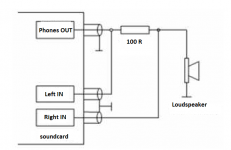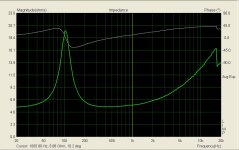I'm trying to get an idea what the impedance curve of my pioneer 2402 clone is.
I did try this tutorial but I didn't get good results. 2 ohms dip with a 8 ohm woofer.
Loudspeaker impedance measurement using a multimeter and 2 resistors
Getting 150mv reading with the resistance with both channel will be way too loud. With only one channel getting 150mv (with 1k ohm resistor) needs to get the volume knob to max.
Then I'm getting 0,000 V reading above 8000hz with the speaker and with the 10 ohm resistor.
Do I need to set the volume knob to get 150mv without the resistor? And do I have too Much resistance and changing the 1k ohm resistor to 200 or 500 ohm would help me?
I did try this tutorial but I didn't get good results. 2 ohms dip with a 8 ohm woofer.
Loudspeaker impedance measurement using a multimeter and 2 resistors
Getting 150mv reading with the resistance with both channel will be way too loud. With only one channel getting 150mv (with 1k ohm resistor) needs to get the volume knob to max.
Then I'm getting 0,000 V reading above 8000hz with the speaker and with the 10 ohm resistor.
Do I need to set the volume knob to get 150mv without the resistor? And do I have too Much resistance and changing the 1k ohm resistor to 200 or 500 ohm would help me?
Since there's a crossover in the speaker do I need the 1k ohm resistance?
If I understand correctly this resistor act as an attenuator, but with the crossover 150mV
is not loud enough to bother me or break the speaker.
The 1k resistor converts the voltage source (the amplifier or signal generator) into a current source.
Then the current (in mA) into the speaker is equal to the voltage (in volts) across the 1k resistor.
The volume level is not critical for measuring the impedance if the readings are accurate.
Last edited:
Room EQ Wizard also will do this much more reliably.
I would like to use REW but I'm using the USB output of my laptop. REW only gives schematic for soundcard output. There is a way to use USB and REW impedance measurement?
I tried a diffrent setup but did not get good results as well.
10 ohm resistor on + line.
I hooked the multimeter 1 on both side of the resistor.
Multimeter 2 on resistor and on - line.
I used Multimeter 1 to get : E/R=I
Then multimeter 2 to get E/I=R.
I mostly got an average of 30 ohm from 10 to 600 hz. I also tried with a woofer out of the speaker ( free air ) and I got the same result. I guess with a nominal 8 ohm woofer I should get I couple of 8 ohm results.
I can get measurements with a dummy load to compare but I don't have the math to compare both results and have an accurate impedance result.
10 ohm resistor on + line.
I hooked the multimeter 1 on both side of the resistor.
Multimeter 2 on resistor and on - line.
I used Multimeter 1 to get : E/R=I
Then multimeter 2 to get E/I=R.
I mostly got an average of 30 ohm from 10 to 600 hz. I also tried with a woofer out of the speaker ( free air ) and I got the same result. I guess with a nominal 8 ohm woofer I should get I couple of 8 ohm results.
I can get measurements with a dummy load to compare but I don't have the math to compare both results and have an accurate impedance result.
I used Multimeter 1 to get : E/R=I Then multimeter 2 to get E/I=R.
What brand and model of meters do you have?
Ok I did the measurements again but this time with a Fluke 289 and I got similar results.
Passed 60hz the impedance begins to dip to 2,3 ohms. I guess the crossover has to much impact to get proper results.
Is there any way to get an impedance curve of a "complet" loudspeaker?
Passed 60hz the impedance begins to dip to 2,3 ohms. I guess the crossover has to much impact to get proper results.
Is there any way to get an impedance curve of a "complet" loudspeaker?
The woofer has a 8 ohm nominal and driver 16 ohnm.
I went on Yuichi Arai's web site, where I get the plans for the horn and cabinet and he measured them and gave the curve.
If my measurements are good the crossover over has a great un on impedance, because the woofer never drop below 8ohms and driver is 16 ohms and up.
Wood Horn
Loudspeaker Enclosure
I went on Yuichi Arai's web site, where I get the plans for the horn and cabinet and he measured them and gave the curve.
If my measurements are good the crossover over has a great un on impedance, because the woofer never drop below 8ohms and driver is 16 ohms and up.
Wood Horn
Loudspeaker Enclosure
If you have audio in/out on your laptop you can use REW. "Soundcard" meaning the audio jacks. You don't need a real physical card.
There's a headphone/microphone plug.
Tu
With this plug and a resistor I should be able to do the REW's procedure?
- Status
- Not open for further replies.
- Home
- Loudspeakers
- Multi-Way
- Need help for impedance curve measurement

